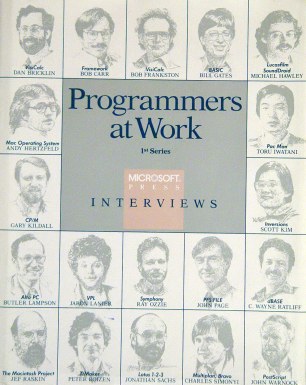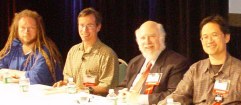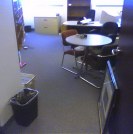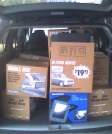danbricklin.com/log
|
||
|
|
Starting March 11, 2004
Segways and special needs, Reading blogs is healthier than watching TV, Programmers at Work reunion, John Seybold dies at 88, Lights out in my old office, End of an era as Trellix office closes
11Mar04-12Apr04
2004_03_11.htm
|
|
|
Segways and special needs [link]
I received an interesting email late last week, and got permission from the author to post it on my website. It's valuable in several respects that are worth noting, including: It reminds us that technology can really make a positive difference in a person's life. It shows that the Segway is of long term valuable in many respects. It shows that posting experiences on the web is of value in ways you may not anticipate. It reminds us of how devastating our treatment of those who appear different can be. It shows how quickly someone can go from outcast to celebrity when they are an early adopter of a technology that has charisma.
Read "Segways and special needs".
Reading blogs is healthier than watching TV [link]
While going through some piles of old mail in my home office, I found an interesting article in Harvard Magazine. (As a Harvard Business School alum I get it in the mail but rarely get to spend time reading it.) In "The Deadliest Sin", author Jonathan Shaw provides lots of scientific research about the benefits of exercise and the dangers of being a couch potato (the "sin" of sloth). Read it for a real kick in the pants to help you remember to exercise. The opening paragraph:
In the bottle before you is a pill, a marvel of modern medicine that will regulate gene transcription throughout your body, helping prevent heart disease, stroke, diabetes, obesity, and 12 kinds of cancer -- plus gallstones and diverticulitis. Expect the pill to improve your strength and balance as well as your blood lipid profile. Your bones will become stronger. You'll grow new capillaries in your heart, your skeletal muscles, and your brain, improving blood flow and the delivery of oxygen and nutrients. Your attention span will increase. If you have arthritis, your symptoms will improve. The pill will help you regulate your appetite and you'll probably find you prefer healthier foods. You'll feel better, younger even, and you will test younger according to a variety of physiologic measures. Your blood volume will increase, and you'll burn fats better. Even your immune system will be stimulated. There is just one catch.
There's no such pill. The prescription is exercise.
- Harvard Magazine March - April 2004, page 36
This is a long article with lots of cited research on many areas, especially about diabetes. To tie this into one of the themes I cover in this weblog, namely using computers and weblogs, here is a passage that caught my eye (emphasis added):
One sedentary behavior in particular has drawn the attention of public-health researchers. In a landmark study that compared watching TV to reading, sitting at a desk, and driving, Hu found that TV watching is far more likely to lead to obesity and diabetes than any of the other sedentary behaviors. First, Hu explains, "when people watch TV, they eat." Second, they tend to make bad food choices: TV watchers eat more junk food and fast food. And when people watch TV, their metabolic rate (the rate at which energy is burned) drops lower than when they sit and read or work on a computer. "The reason is that TV watching is completely passive," says Hu. "It is almost like sleeping -- sit back and relax -- that's the message." People who watch TV also tend to spend a lot of time at it (women watch at least an hour more per day than men). And so prolonged TV watching -- Hu calls it "a major public-health hazard" -- displaces other activities that would be better for people's health. Gortmaker, who pioneered studies of television watching among American children (60 percent of whom have a television in the room where they sleep), notes that among youth, time spent watching television is the one behavioral variable most predictive of obesity.
- Page 38
So, blogs are better for you than TV (and writing one is probably better than reading, I'd guess). But walking or running (even while listening to your MP3 player) is even better.
Programmers at Work reunion [link]
Last night I participated in the Programmers at Work reunion at CMP's Software Development Conference and Expo in Santa Clara, California. It brought together seven of the 19 programmers profiled in the now out of print book along with interviewer Susan Lammers as moderator. They contacted most of the subjects that are still living and these were the ones who could make it last night. (The book is copyright 1986 by Microsoft Press.)
Here are some pictures:
 My hard bound copy of the original book
  Jaron Lanier, Robert Carr, Jef Raskin, Scott Kim, Andy Hertzfeld, and Charles Simonyi on stage
  Andy and Robert with audience member Tony Wasserman, Jaron
   Jef and Scott, Charles, and Susan Lammers
 Some of the audience right before the start (about 300 people attended it seemed)
Susan started the night off by introducing us and asking what we were up to now. Charles Simonyi is working on coming up with a better way to express programs at Intentional Software Corporation. Andy Hertzfeld has been programming for years, most recently at OSAF with Mitch Kapor, but after a year and a half is taking a break. I'm back on my own at Software Garden, starting to think about creating some new software tools and doing consulting (the event served as a way to say that publicly to a West Coast audience...). Scott Kim is a professional, independent puzzle designer. He's been designing puzzles for publications and now creating daily ones for cell phones. (That was probably the coolest current job.) Jef Raskin is consulting and still working on a better interface. Robert Carr was most recently a venture capitalist, after doing GO and helping Autodesk successfully move from DOS to Windows, but is now taking time off. Jaron Lanier is still interested in a better way of programming (like Charles), and is deep in the National Tele-immersion Initiative. Twenty years later, there are constant threads in our careers.
The panel was too intense to both participate in and take notes at the same time. You'll have to find someone else's report. The only note I made was about an anecdote that Charles told. He doesn't usually carry much in the way of ID. He was stopped at the guard desk at a company where he had an appointment. No ID, no entry. He asked if the guard had web access on the computer on his desk. He did. Charles told him to look on Google for "Charles Simonyi". Up popped his picture. Yep, that's him. He was let through.
Before the event we took turns autographing each other's copy of the book (for the few of us who remembered to bring it and could find it).
In preparation, I read a lot of the book on the plane. I found the book fascinating. Hopefully it will be reissued. Susan explained to me that the rights to it have reverted to her, and she's trying to figure out what to do. We discussed various ideas. I think that it really has lots of material from which we can still learn, especially in hindsight.
There are a variety of common threads that you find in many of the interviews. "Design the data structures first" comes through loud and clear. One of the questions Susan asked us to think about was Open Software, so I was looking for quotes related to that. Here are a few I found:
The Danish computer also had an incredible influence on me. At that time, it had probably the world's best Algol compiler, called Gier Algol. Before I went to Denmark, I had complete listings of the compiler, which I had studied inside and out... It was designed by Peter Naur. He's the letter N in BNF... I knew that program inside and out and I still know it.
- Charles Simonyi, page 10
Interviewer: How else can you build your repertoire as a programmer?
Kildall: You need to study other people's work. Their approaches to problem solving and the tools they use give you a fresh way to look at your own work...
Interviewer: ...Has anyone or anything influenced your style of programming?
Kildall: ...I learned that style from an early Burroughs 5500... The ALGOL compiler was probably one of the nicest pieces of code to come out at that time. I spent hours trying to fix and change the compiler. Working with it so closely affected the way I think about programming and had a profound influence on my style...
- Gary Kildall, pages 62-63
The really great programs I've written have all been ones that I have thought about for a huge amount of time before I ever wrote them. I wrote at BASIC interpreter for a minicomputer in high school. I made massive mistakes in that program, and then I got to look at some other BASIC interpreters. So by the time I sat down to do Microsoft BASIC in 1975, it wasn't a question of whether I could write the program, but rather a question of whether I could squeeze it into 4K and make it super fast....
...One of the most fun programming experiences I ever had was when we were doing BASIC. I had done the 8080 BASIC, and then I had about two weeks allocated to work with Mark Chamberlain on the 6809 version of BASIC. I read the instruction set at the start of the two weeks, and I wrote about three or four programs. And I looked at some other programs to see how people used the instruction set. It was great fun to take a problem I understood and map it onto this new instruction set, and see how tightly we could put the thing together...
...I really get satisfaction from somebody else on the team becoming a great programmer. Not quite as much as I do from writing the program myself, but that is a really positive event. The way I make someone else a great programmer is to sit and talk with him a lot, and I show him my code. In a team project, you make the code everybody's code...
Interviewer: Is studying computer science the best way to prepare to be a programmer?
Gates: No, the best way to prepare is to write programs, and to study great programs that other people have written. In my case, I went to the garbage cans at the Computer Science Center and I fished out listings of their operating systems.
You've got to be willing to read other people's code, and then write your own, then have other people review your code. You've got to want to be in this incredible feedback loop where you get the world-class people to tell you what you're doing wrong...
- Bill Gates, pages 76, 77, 80, 83
It's clear that being able to read the code of others is very important in the world of software. It is something that is at the heart of the Open Source movement and now even available to many parties from Microsoft. There are differences in philosophies about what others can do with the source to which they have access, but the desire to teach others is very widespread, not just the desire to take from others.
While the quotes from Bill Gates may surprise his critics, especially in the Open Source world, I found them to fit in well with his whole interview. You see someone extremely devoted to doing the best job possible and getting deep into details. From Charles Simonyi and him you see managers focused on nurturing the best out of their employees and teaching them all that they know. It's not the image you get today of other CEOs who plead ignorance of the details of their company's operation. This book is from a simpler time and the candor of the interviews is wonderful. Hopefully Susan will work out a way for it to come out again and for us all to build off of it.
John Seybold dies at 88 [link]
The New York Times reported this morning that John Seybold, the computerized typesetting pioneer, died this past Sunday. He was a very important figure in the world of using text on computers. He was "the" consultant for years, and even now his children, Andrew, Jonathan, and Patricia, continue to be influential consultants. But, more importantly, he was involved in computerized typesetting from early on, and was an advocate by doing.
I was introduced to John as an important person by my father when I was still in school. My father was taking a course in computerized typesetting given by John in New Jersey. I got to visit the place once, and saw the equipment (Photon typesetter that used a strobe and a spinning wheel with type images, huge RCA computer) and heard about their setting of the Bible. Later, it just so happened that I worked at DEC on Typeset-10 and one of our three main customers was the Palm Beach Post, which, according to the Times' article is where John Seybold got inspired to enter the field. The people I worked with remembered as a child having the typesetter they were experimenting with housed in their bedroom or something, as I recall. I saw John a couple of years later when we brought him in as a consultant to look at our word processing system.
According to the Times, John played a key role in getting Atex accepted, bringing computerized typesetting and editing to newspapers and magazines. Paul Brainerd later worked at Atex and left to form Aldus and ship PageMaker, which was a major early player in desktop publishing. These early pioneers leave many tracks that lead to today's important products. May John rest in peace and his family be comforted.
Lights out in my old office [link]
With the office winding down, I had to move my stuff out earlier than I expected. (They had been nice and not forced me to find places for everything when I quit last month, which also encouraged me to come in and visit frequently as I slowly sorted through old files. I threw out a lot.) Today I put the boxes in the car and possibly turned off the lights for the last time. I forgot to bring a camera, but then remembered to use my Treo 600's "camera". It is nice to have a "back up camera" with you all the time.
    Moving on
End of an era as Trellix office closes [link]
Today Interland announced the closing of the Concord, MA office, the old Trellix place, and fired most of the employees. I found out when one of them notified me by email and I went into the office to say goodbye to people. This was a sad surprise to me.
Pretty much the entire development team was let go. Really good people. This is a team that has worked together for many years -- some as long as 8 years starting when we opened our first office and started development in April 1996.
It was sad for me when I left on my own last month, but I've been going back for lunch every week and keeping in touch with people. This is worse for us all as we lose a great place to be together and to see the good work being turned out by each other. It is sad to see a close-knit team of such skilled people broken apart.
People are now out looking for jobs. If anybody in the Eastern Massachusetts area is looking for developers with a wide variety of skills, who know how to ship award winning products, send me an email and I'll pass it along (no headhunters, please). Send it to "trellix at bricklin dot com".
So, this is probably the end of the Trellix journey. The code of the browser-based authoring tool will move down to Atlanta, but the programmers are not. The original group that helped me craft a vision for authoring hypertext and web sites in 1996 that led to Trellix 1.0, and the succession of wonderful products that followed is now pretty much completely disbanded. It was a great ride, one that we really enjoyed. Good luck and thank you to all of those who were part of it.
|
||
|
© Copyright 1999-2018 by Daniel Bricklin
All Rights Reserved.
See disclaimer on home page.
|
||